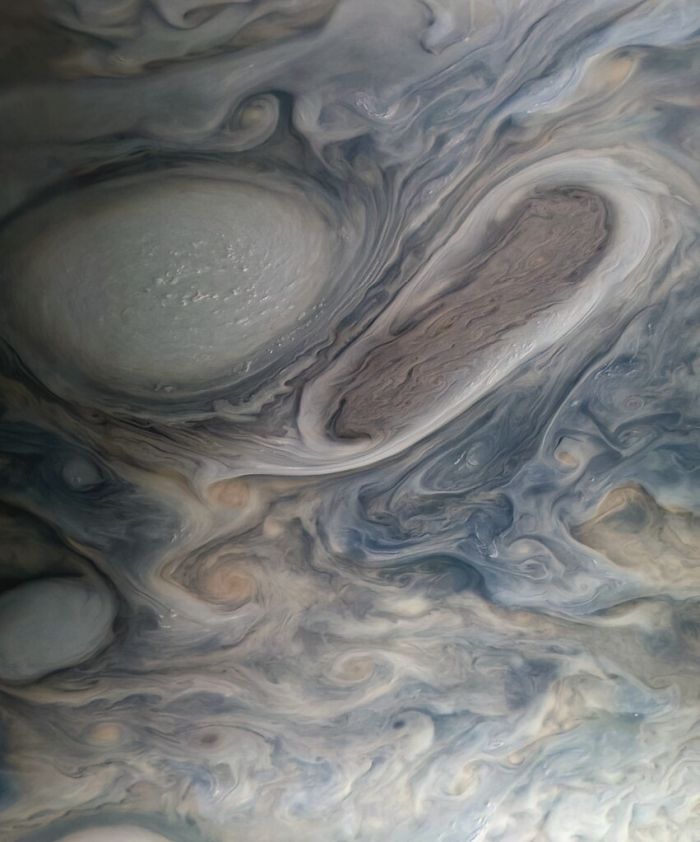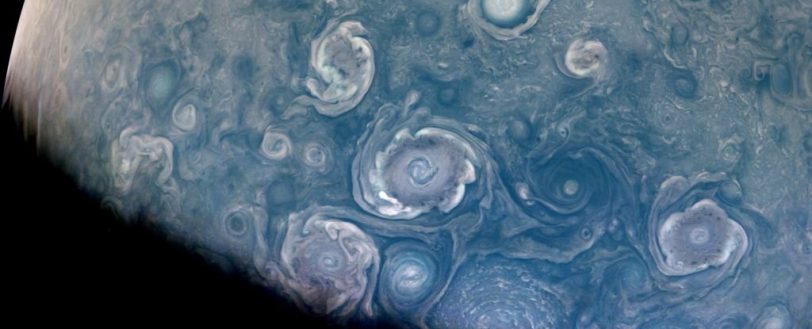The poles of Jupiter have fascinated and mesmerized us ever since space probe Juno gave us our first breathtaking views of the regions.
In one of the latest pictures Juno has sent back of the north pole, you can see why: a medley of storm vortices, connected and interconnected, appearing serene from a distance but raging with an intensity we can only imagine here on Earth.
On 5 July, Juno made its 43rd close flyby of our Solar System’s giant planet, skimming a relatively close 25,100 kilometers (15,600 miles) above the polar cloud tops. Jupiter’s poles are not visible to us most of the time due to its axial orientation, so planetary scientists rely on Juno data to study the atmospheric dynamics at play in these mysterious and tempestuous regions.
Zoom in to the cloud tops of Jupiter, however, and you begin to get a sense of the mind-boggling scale and ferocity of the planet’s weather, as seen in this prior image processed by NASA engineer Kevin Gill, embedded below.

“These powerful storms can be over 30 miles (50 kilometers) in height and hundreds of miles across,” a JPL NASA spokesperson wrote on the JPL website.
“Figuring out how they form is key to understanding Jupiter’s atmosphere, as well as the fluid dynamics and cloud chemistry that create the planet’s other atmospheric features. Scientists are particularly interested in the vortices’ varying shapes, sizes, and colors.”
Each of Jupiter’s poles has its own unique storm configuration. The south pole has – or rather, had – six cyclones, each the size of the continental United States, one in the center and five storms arranged in an almost-perfect pentagon around it, all spinning clockwise.
Between Juno flybys, scientists noticed the appearance of a seventh storm, transforming the pentagon into a hexagon. (This is in contrast to Saturn’s northern polar hexagon, which consists of a single hexagonally shaped storm.)

The north pole is even stranger: scientists discovered nine storms there, eight clustered around one in the center and all spinning counterclockwise. Other vortices rage in the high latitude regions surrounding both of these central polar storm concatenations.
Using Juno data, scientists discovered a mechanism that prevents these storms from merging into a single mega-storm, as seen at Saturn’s poles. The ability to track changes between Juno flybys is one of the most important tools planetary scientists have for understanding Jupiter’s wild weather, particularly at its poles.
Citizen scientists can also participate. A citizen scientist created the above image using Juno raw data. If you want to try your hand at this, the BBC’s Sky at Night Magazine has a pretty detailed how-to guide here. Juno’s raw images can be found here.
Citizen scientists can also use Zooniverse’s Jovian Vortex Hunter to help identify and classify cyclone storms on Jupiter. This is a tool that will directly help planetary scientists understand this strange world.
If you like the image above, you can get a high-resolution version from the JPL NASA website.
READ MORE: This Video of Europa and Io Orbiting Jupiter Is Not Fake; In Fact, It Is 100% Real


